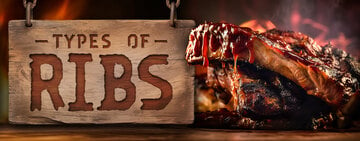Whether you run a steakhouse, restaurant, or sports bar, knowing the differences between smoking and grilling is essential. Though these forms of cooking are used interchangeably, there are significant differences between them. To optimize your menu and make informed decisions on what types of equipment to buy, it’s important to understand what sets smoking and grilling apart.
Shop All Commercial SmokersSmoking vs Grilling
The difference between commercial smokers and commercial grills is how they cook. Though these appliances may look similar, they are designed for different purposes. To learn more about these cooking methods as well as the different types of smokers and grills available to you, continue reading below.
Grilling Definition

Grilling involves applying direct and indirect heat to food, typically over a grate. Cooking with direct heat refers to placing food directly above the heat source, while cooking with indirect heat refers to placing food adjacent to the source. In most cases, grills apply heat from below, but it’s important to note that some grills can apply heat from the side or above. Grills cook various types of meat including beef, pork, poultry, and fish, as well as some vegetables and fruits.
From Argentinian BBQ to backyard cookouts, grills play a significant role in social gatherings. In general, there are three different types of grills:
- Gas grills: Gas grills are convenient, affordable, and versatile. They heat up quickly, have simple controls, and are often designed with a variety of additional features to improve the grilling process.
- Charcoal grills: Charcoal grills are considered the traditional way to grill. They typically require charcoal briquettes, wood chips, or another similar material and leave foods with a smokey taste.
- Electric grills: Electric grills offer an alternative if you cannot use a gas or charcoal grill. They often feature a compact design and require less maintenance than their counterparts.
Smoking Food Definition

Smoking requires foods to be exposed to smoke while they cook. They use several different fuel sources including charcoal briquettes, wood pellets, and even wood logs, each of which gives the food a slightly different flavor. A smoker cooks foods with indirect heat, resulting in a different taste and texture than grilled foods.
There are several different types of commercial smokers to choose from:
- Smoker ovens: Smoker ovens are designed for indoor use and can be convenient if you don’t have access to an outdoor cooking space. Many of them utilize real wood chips and are ideal for people who are new to the smoking process.
- Smoker grills: Smoker grills are recognized as the ideal way to cook food “low and slow.” They are designed for outdoor use and run on charcoal, wood, or liquid propane.
- Offset grills: This type of smoker offers an authentic smoking experience. These grills are outfitted with a firebox, which produces smoke and releases it into a cooking chamber to give foods a smoky flavor and crisp texture.
- Vertical pellet smokers: A vertical pellet smoker places food above the fuel source, causing smoke to disperse evenly around whatever you are cooking. These types of smokers are designed for outdoor use and excel at cooking foods overnight or for extended periods.
- Indoor smokehouses: An indoor smokehouse is a large appliance that uses vertical space to cook large amounts of food. Meant for indoor use, they are ideal for kitchens looking to cook large quantities of food while conserving space.
Difference Between Smoking and Grilling
The three main differences between grilling and smoking are what types of foods you are cooking, what temperature they are cooked at, and how long you cook them. To learn more about each difference, continue reading below:
- Temperature: Grilling is often done at high heat, typically reaching 400 and 550 degrees Fahrenheit. Conversely, you should smoke foods at lower temperatures, usually between 225 and 250 degrees Fahrenheit.
- Cook time: For the best consistency and flavor, grill foods for short periods. Contrastingly, the key to smoking is to let the food absorb the smoke and flavor over several hours. It’s important to note that how long you grill or smoke foods can vary depending on what you are cooking and how much you want to serve.
- Types of food cooked: While overlap is possible, smoking and grilling are used for different types of food. Grilling is often used to cook smaller foods in larger quantities, such as burgers, hot dogs, and steaks. Many people also grill fruits or vegetables such as peppers, corn, and pineapple. Meanwhile, smoking is often reserved for larger meals such as pork roasts, whole poultry, and various types of fish, though you can also smoke some cheeses and vegetables.
What Is Barbequing?
Barbequing describes several different cooking methods and techniques. Depending on where you are in the world, it may be called barbie or braai. Barbequing refers to the process of cooking foods for long periods over low heat, or “low and slow”. Smoking is a form of barbequing, while grilling is not.
FAQ
Whether you’re new to smoking and grilling or are just looking to learn more about the subject, chances are you’ll have several questions. Below, we’ve answered some of the most common questions about smokers, grills, and other ways to prepare meat.
Is a Smoker a Grill?
No, a smoker is not a grill. Commercial smokers use indirect heat to cook and flavor foods, while grills rely on direct heat.
Can You Use a Smoker as a Grill?
Smokers can be used for grilling. However, doing so may not be efficient or cost-effective. To achieve the necessary temperature for grilling while using a smoker, you must maintain a hot fire
Can a Charcoal Grill be Used as a Smoker?

It is possible to use a charcoal grill as a smoker. Charcoal grills are not designed with smoking in mind, meaning you'll have to take extra steps to do so. This includes the following steps:
How to Smoke on a Charcoal Grill
- Light charcoal: Fill a chimney starter with charcoal briquettes and light them.
- Add charcoal: Add the lit briquettes to the grill. Be sure to keep them segmented on one side of the grill to create indirect heat.
- Add pan: On the other side of the grill, add a disposable foil pan.
- Fill pan: Add 2-3 cups of water to the pan to maintain a lower cooking temperature.
- Let coals burn: Allow the coals to burn down for 30 minutes to an hour, raising the temperature of the water.
- Add wood chips: Once the water reaches an optimum temperature, add dry wood chips.
- Add food and cook: Once the wood chips have been added, you are free to add food to the grill.
Understanding the differences between grilling and smoking is essential to curating a quality menu. Doing so can also help guide your decisions when buying equipment for your kitchen. By adhering to the information above, you’ll be able to provide your guests with foods that feature a variety of flavors and textures.



